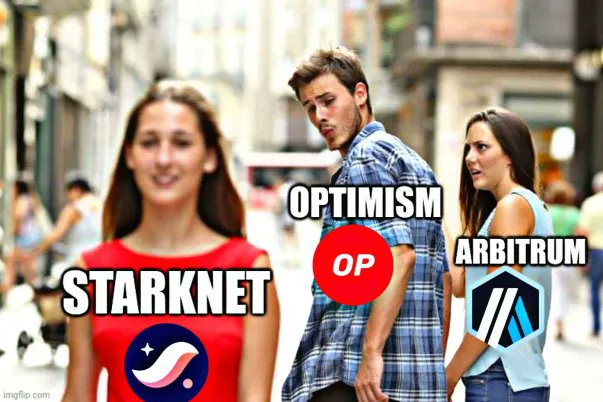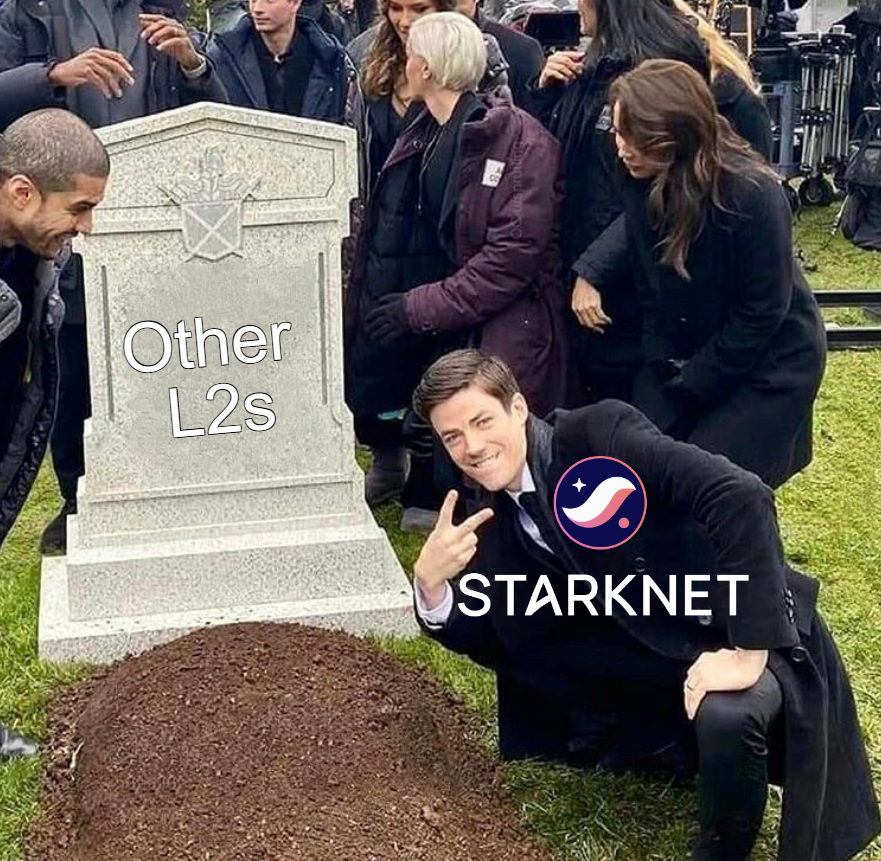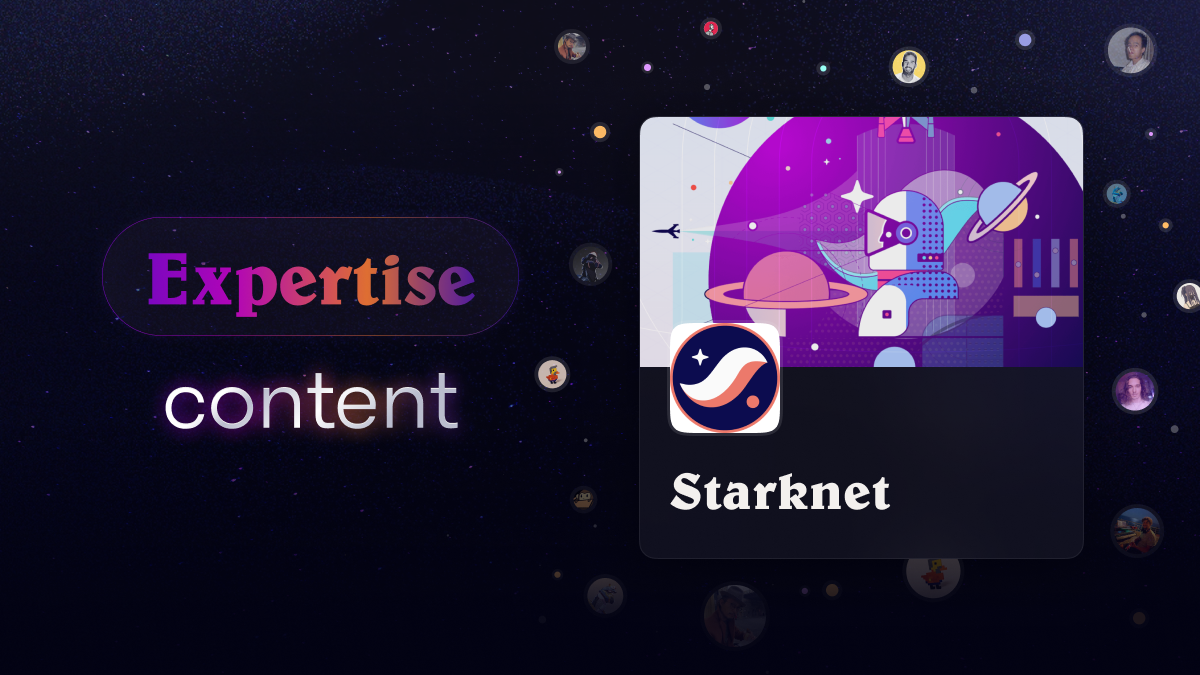Have you ever wondered what sets Starknet apart from other Layer 2 scaling solutions in the blockchain space?
Ever wondered how Starknet is revolutionizing the world of blockchain?
Imagine a superhighway where Ethereum is the main road, often congested with traffic. Starknet is like a high-speed express lane, easing congestion and offering a faster, smoother ride.
In the rapidly evolving landscape of decentralized technologies, Starknet has emerged as a standout performer, offering a unique set of features and capabilities that contribute to its exceptional performance.
In this article, we'll delve into the details of Starknet and explore what makes it outshine its counterparts.
Background
Blockchain networks, especially Ethereum, are like bustling cities with heavy traffic – they face challenges of slow movement and high costs. Layer 2 solutions, like Starknet, are here to unclog these roads, making transactions quicker and cheaper.
Starknet, developed by StarkWare, takes a novel approach to overcome these challenges, utilizing cutting-edge technology to elevate the user experience within the decentralized ecosystem.
Differences between Layer-1 solutions & Layer-2 solutions
Just to clarify as you may come across these terms quite often: layer-1 solutions refer to the main Ethereum blockchain, where all transactions are settled. Layer-2 solutions are built on top of Layer-1 to alleviate scalability issues, offering faster and more cost-effective transactions. They are like additional layers that leverage the security of the main chain while handling transactions more efficiently.
Expectations
In the following sections, we will unravel the key aspects of Starknet that contribute to its superior performance. From a detailed introduction to practical examples and addressing common misconceptions, this article aims to provide a comprehensive understanding of why Starknet stands out among its peers.
The Essence of Starknet
Starknet, a decentralized validity-rollup, functions as a crucial layer atop the Ethereum blockchain. This Layer-2 solution addresses Ethereum's scalability challenges by enabling off-chain transaction processing while maintaining transaction summaries on the Ethereum mainnet.
By grouping transactions into batches and processing them off-chain, Starknet significantly enhances transaction throughput and reduces costs without compromising composability and security. Leveraging STARK (Scalable, Transparent ARgument of Knowledge) proofs for verifiable computation, Starknet ensures the integrity of off-chain transactions on the Ethereum mainnet without redundant execution.
Let’s take a look at each term below:
- Batch Processing: Starknet groups many transactions (pieces of paperwork) into a single batch (a big folder). Instead of handling each transaction individually in a busy office (Ethereum mainnet), Starknet processes these batches separately in a more efficient space (off the Ethereum mainnet). This is like taking a big folder to a quiet room to organize everything at once, instead of sorting each paper amid the office chaos.
- Enhanced Transaction Throughput and Reduced Costs: By handling transactions in batches off-chain, Starknet greatly increases the Ethereum network's speed while reducing transaction costs.
- STARK Proofs for integrity and security: To make sure everything is done correctly and securely in this separate space, Starknet uses a special method called STARK proofs. Think of these as super-accurate checklists that ensure every single transaction in the batch is valid and error-free. This guarantees the integrity of the transactions, without redundant checks.
- Composability and Security: Despite off-chain processing, transactions maintain seamless interaction with the Ethereum system, preserving their interconnectedness and security.

In essence, Starknet's innovative architecture strikes a balance between off-chain efficiency and on-chain security, providing a scalable solution that augments the broader Ethereum ecosystem.
Core Aspects Unveiled
The Challenges Faced by Ethereum
At the core of Starknet’s importance, is the recognition of Ethereum’s growing pains. As blockchain technology adoption continues to grow rapidly, Ethereum's network struggles with increasing transaction volumes, leading to high gas fees and a potentially elitist environment. From a scaling perspective, it becomes evident that Ethereum's network encounters limitations, and achieving mass adoption seems implausible without the intervention of Layer-2 solutions like Starknet.

Starknet's Solution to Ethereum's Scaling Dilemma
Positioned as a permissionless validity-rollup, Starknet seamlessly integrates with Ethereum's security using its scalable cryptographic proof system: STARK.
In essence, Starknet operates as a Layer-2 solution that transcends the scaling limitations of Ethereum. By tapping into the security of Ethereum through STARK, Starknet can handle a multitude of transactions, providing the scalability necessary for a decentralized future. This pivotal role positions Starknet as a cornerstone in the pursuit of widespread blockchain adoption, overcoming the hurdles posed by Ethereum's scaling constraints.
Comparison between the existing L2 Solutions
So now that we have seen the essence of Starknet and how it offers a solution to the challenges faced by Ethereum, let’s have a look at how they compare to other existing L2 solutions.
As a reminder, Starknet’s technology operates as a decentralized validity-rollup. It uses STARK (Scalable Transparent ARguments of Knowledge) proofs, offering high scalability and quantum resistance. A key differentiator is its Cairo programming language, specifically designed for creating STARK proofs. This facilitates efficient off-chain computation while maintaining on-chain integrity.
Basically, Starknet is particularly effective for complex computations, and its low transaction costs make it a favorable choice for DeFi, gaming, and NFTs.
Optimism
Optimism, on the other hand, is an Optimistic Rollup solution. It assumes transactions are valid by default and only runs computations in the case of a challenge, which speeds up transaction processing.
It’s unique feature is that it is EVM-compatible, meaning it can directly run unmodified Ethereum smart contracts. This lowers the barrier for developers who are already familiar with Ethereum's environment.
Optimism is thus focused on scalability and user experience, providing a fast and inexpensive way to interact with Ethereum. It is popular among DeFi applications and has a growing community of developers and users.
Arbitrum
Like Optimism, Arbitrum is also an Optimistic Rollup. It enhances Ethereum's capabilities by enabling off-chain computation while keeping data on-chain.
Unlike the other L2s, Arbitrum stands out with its unique dispute resolution mechanism, which efficiently handles any challenges to transaction validity. It also offers high compatibility with Ethereum's tooling and smart contracts.
Arbitrum has therefore quickly become a hub for DeFi projects and other applications seeking scalability without sacrificing security. Its ability to support complex smart contracts has attracted a diverse range of developers and users.

Key differences between Starknet & other L2s
Diving deeper, Starknet's use of proofs, specifically STARK proofs, distinguishes it from other L2 solutions.
STARKs, unlike SNARKs (Succinct Non-interactive ARguments of Knowledge), don't require a trusted setup, enhancing transparency and security.
In Starknet, STARK proofs verify the integrity of transactions processed off-chain. These proofs are generated and verified on the Ethereum mainnet, updating Starknet’s state root. Imagine sending a package with a super-secure, tamper-proof seal. STARK proofs' scalability and robust security make them ideal for applications that value privacy and efficient verification.

To go more in detail, proofs are generated for the created blocks and transactions from the sequencer, wherein it uses Cairo’s Virtual Machine to run provable programs, thereby creating execution traces necessary for generating STARK proofs. Which is then verified on the L1, where there exists a smart contract that is capable of verifying these STARK proofs. Once the proof is verified the Starknet’s state root on L1 is updated (as shown in the above diagram).
STARK proofs are thus a cornerstone of StarkNet's capabilities, enabling it to process a vast number of transactions both securely and efficiently. Picture it as a bullet train for your transactions: incredibly fast yet exceptionally safe.
Now, let's explore other key distinctions that set Starknet apart from other Layer 2 solutions:
First off, you got its use of the Cairo Language. Starknet uses its own programming language, Cairo, designed specifically for creating STARK proofs. This strategic choice diverges from the norm of using languages like Solidity, common in Ethereum smart contracts. Cairo's tailored design boosts its efficiency in STARK proof generation, underlining Starknet's commitment to specialization.
Second, Starknet chooses specialization over EVM (Ethereum Virtual Machine) compatibility, allowing it to fine-tune its network for specific use cases such as:
- Finance and Trading: StarkNet can optimize its network for high-frequency trading platforms or complex financial instruments, which require fast and efficient processing of numerous transactions and smart contracts.
- Data-Intensive Applications: Applications that involve heavy data processing, such as decentralized machine learning algorithms or large-scale data analysis, can benefit from StarkNet’s ability to handle more complex computations off-chain efficiently.
This therefore encourages innovation and supports unique applications that may not be feasible within traditional EVM-compatible environments.

Thirdly, Starknet processes a significantly higher number of transactions per second than Ethereum's mainnet, addressing scalability issues. By increasing transaction batch sizes and optimizing network efficiency, it reduces transaction costs, alleviating the burden of high gas fees.

And lastly, you’ve got a great Quantum computing resistance via Starknet. Thanks to ZK-Stark, the ecosystem is prepared against potential threats from quantum computing, ensuring long-term network security.
These differences, summed up collectively, highlight Starknet’s potential as an exceptional and stimulating platform for developers. The array of benefits it offers from scalability and security to economic efficiency and quantum resistance, make it an attractive environment for building a wide variety of applications. This in turn is reflected in the numerous applications that have already been successfully developed and launched on Starknet, which we will conclude the article with.

What’s been building in Starknet
As we wrap up our exploration of Starknet's innovative architecture and its comparison with other Layer 2 solutions, we can conclude that Starknet is a significant force in reshaping decentralized technologies. This innovative platform has not only shown great versatility but also encourages the development of impactful real-world applications.
Here are some examples of the innovative projects and applications that have been developed on Starknet:
- Bridges like YAB (Yet Another Bridge) is a bridge between Ethereum and Starknet. It allows you to transfer tokens from Ethereum to Starknet and vice versa. In such a way that the mint function will be allowed if and only if there is a valid Storage Proof created by Herodotus (Building storage-proof technology to enable synchronous cross-layer data access) and registered in the FactRegistry.
- AMMS for Starknet are such as Jediswap, ekubo. And a well known AMM aggregator is AVNU.
- NFT based project such as Focus Tree which is a productivity app leveraging the power of communities and web3 to protect their most precious asset - time.
- NFT collections such as Ducks Everywhere, which is an NFT collection of handcrafted ducks made from briqs. Where each duck is uniquely created and selected by the community, sold through auctions. And three new ducks are minted and auctioned weekly.
- Game engines such as Dojo is a provable game engine and toolchain for building onchain games and autonomous worlds. Few of the well known projects are Realms.world and DopeWars.
- Money markets such as hashstack which provides a permissionless zk-native money market protocol enabling secure under-collateralised loans.
Even you can build your very own DApp 😉!
If you are inspired, as a tip, engaging with the Starknet developer community and resources is a great way to get started with building on this Layer-2 solution. And if you want to delve deeper into this exciting journey, you can:
- Stay Informed about Layer-2 Developments, especially those like Starknet. Follow reputable sources, blogs, and official announcements to understand how these technologies evolve and their potential impact on various industries.
- Engage with the community, forums, and discussions related to Ethereum Layer-2 solutions. Engaging with the community provides valuable insights, allows networking with experts, and facilitates a deeper understanding of the practical implications of these technologies.
- Experiment with Starknet Development. For developers, consider experimenting with StarkNet development. Explore the developer documentation, participate in hackathons, and contribute to the growing ecosystem. Hands-on experience will enhance your understanding and skills in leveraging Layer-2 solutions.
As a reminder, OnlyDust is a platform that helps connect developers with the most exciting open-source projects. The added bonus? A strong community and rewards for contributions.
Looking forward to seeing you onboard!
